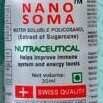From Laboratory to Market: The Journey of Nanoemulsified Long-Chain Alcohols
Introduction
In the ever-evolving field of biotechnology, the transition of innovative solutions from the laboratory to commercial markets is crucial for advancing industries such as pharmaceuticals, cosmetics, and food science. One emerging technology gaining traction is the nanoemulsification of long-chain alcohols. This process not only enhances the solubility, stability, and bioavailability of these compounds but also opens new avenues for product formulation and application. This article delves into the intricate journey of nanoemulsified long-chain alcohols from the laboratory setting to market-ready products.
Understanding Nanoemulsification and Long-Chain Alcohols
Nanoemulsions are finely dispersed systems consisting of two immiscible liquids, wherein one is dispersed in the other in the form of nanometer-sized droplets. Long-chain alcohols, typically comprising 12 or more carbon atoms, are soluble in organic solvents and possess distinctive surfactant properties. By utilizing nanoemulsification techniques—such as high-pressure homogenization or ultrasonication—researchers can significantly increase the stability and solubility of these long-chain alcohols, enabling their effective use in diverse applications.
The Research Phase: From Concepts to Experimental Applications
The journey of nanoemulsified long-chain alcohols begins with robust research and development. In the laboratory, scientists explore the ideal formulation parameters, such as the specific type of long-chain alcohol and emulsifiers used, particle size distribution, and stability testing. This phase is critical, as achieving the right balance allows for effective application and function in products. For example, in pharmaceutical formulations, the delivery of poorly soluble drugs can be enhanced by incorporating nanoemulsified long-chain alcohols, which improve absorption rates.
Innovative techniques such as Fourier Transform Infrared Spectroscopy (FTIR) and Dynamic Light Scattering (DLS) are employed to characterize the physical and chemical properties of the nanoemulsions. Additionally, in vitro studies assess cytotoxicity and bioactivity, ensuring that these novel formulations meet safety standards before moving on to further phases of development.
Scaling Up: Challenges in Transitioning to Industrial Production
Transitioning from laboratory-scale production to commercial-scale manufacturing poses significant challenges. One major hurdle is the consistency of the nanoemulsion quality during scaling. Factors like equipment limitations, variations in raw material quality, and environmental conditions must be carefully controlled to maintain product uniformity.
To overcome these challenges, researchers and manufacturers must engage in systematic scale-up studies to transition their complex laboratory protocols into streamlined industrial processes. Collaborations with engineering firms experienced in food and pharmaceutical manufacturing can facilitate this transition by providing access to the necessary technologies and expertise for large-scale production.
Market Viability: Regulatory Approval and Commercialization Strategies
Once the nanoemulsified long-chain alcohol product has been refined and scaled, the next step involves navigating the regulatory landscape. Compliance with local and international authorities, such as the U.S. Food and Drug Administration (FDA) or the European Food Safety Authority (EFSA), is essential to ensure the product’s safety and efficacy. This phase typically requires extensive documentation, clinical testing, and adherence to Good Manufacturing Practices (GMP).
In parallel, engaging with stakeholders, including potential investors, manufacturers, and distributors, is critical for successful commercialization. Formulating a clear market strategy that highlights the benefits of nanoemulsified long-chain alcohols—such as improved solubility and enhanced product stability—can facilitate entry into competitive markets. Educating consumers and the industry about the advantages of these novel formulations is vital for driving demand.
Diversified Applications: From Pharmaceuticals to Personal Care Products
The versatility of nanoemulsified long-chain alcohols makes them suitable for various industries. In pharmaceuticals, they serve as carriers for bioactive compounds and enhance the efficacy of drugs, particularly those that struggle with solubility. In cosmetics, these formulations can improve skin penetration and stability, leading to more effective anti-aging creams and moisturizers. The food industry can also benefit from these formulations by improving the delivery of flavors and preservatives.
Conclusion
The journey of nanoemulsified long-chain alcohols from laboratory breakthroughs to market-ready products exemplifies the intersection of science and commerce. Despite the inherent challenges of scaling, regulatory compliance, and market integration, the potential of these innovative compounds is vast. As industries continue to embrace the advantages provided by nanoemulsification, the future promises to bring enhanced products that benefit consumers and redefine standards across multiple sectors. With ongoing advancements and collaborations, the path from laboratory to market for nanoemulsified long-chain alcohols is poised for success, leading to impactful innovations and improved formulations worldwide.
